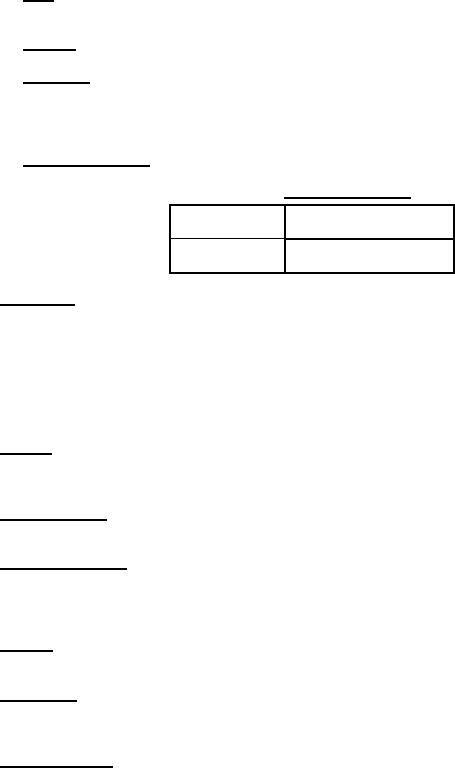
MIL-PRF-22684F
6.2.2.1 Style. The style is identified by the two-letter symbol "RL" followed by a two-digit number; the letters
identify insulated, film, fixed resistors, and the number identifies the size and power rating of the resistors.
6.2.2.2 Terminal. The terminal is identified by the single letter "S" indicating solderable.
6.2.2.3 Resistance. The nominal resistance value expressed in ohms is identified by a three digit number; the first
two digits represent significant figures and the last digit specifies the number of zeros to follow. Minimum and
maximum resistance values are as specified (see 3.1). The standard value for every decade follows the sequence
demonstrated for the "10 to 100" decade table.
6.2.2.4 Resistance tolerance. The resistance tolerance is identified by a single letter in accordance with table VII.
TABLE VII. Resistance tolerance.
Symbol
Resistance tolerance
Percent (±)
G
2
J
5
6.3 Qualification. With respect to products requiring qualification, awards will be made only for products that are, at
the time of award of contract, qualified for inclusion in the applicable QPL whether or not such products have actually
been so listed by the date. The attention of the contractors is called to these requirements, and manufacturers are
urged to arrange to have the products that they propose to offer to the Federal Government tested for qualification in
order that they may be eligible to be awarded contracts or purchase orders for the products cover by this
specification. The activity responsible for the QPL and, information pertaining to qualification of products may be
obtained from the Defense Supply Center, Columbus, (DSCC-VQP) Post Office Box 3990, Columbus, OH 43218-
3990.
6.4 Derating. The intention of this specification is to cover resistors capable of full-load operation at any ambient
temperature up to 70°C. However, if it is desired to operate these resistors at ambient temperatures greater than
70°C, the resistors should be derated in accordance with figure 1.
6.5 Maximum voltage. The maximum continuous working voltage specified for each of the styles (see 3.1) should
in no case be exceeded, regardless of the theoretically calculated rated voltage (see 3.6).
6.6 Resistance tolerance. Designers should bear in mind that operation of these resistors under the ambient
conditions for which military equipment is designed, may cause permanent or temporary changes in resistance
sufficient to throw them out of their initial tolerance. In particular, operation at extreme temperatures may cause
relatively large temporary changes in resistance.
6.7 Shelf life. Resistors are not expected to change in resistance more than 0.2 (average) percent per year under
normal storage conditions (25°C ±10°C with a relative humidity not exceeding 90 percent).
6.8 Flammability. It should be noted that this specification contains no requirements concerning the flammability of
the material used in the construction of the resistors. Users should take this into consideration when a particular
application involves this requirement.
6.9 Tin whisker growth. The use of alloys with tin content greater than 97 percent, by mass, may exhibit tin
*
whisker growth problems (see 3.4.3) after manufacture. Tin whiskers may occur anytime from a day to years after
manufacture and can develop under typical operating conditions, on products that use such materials. Conformal
coatings applied over top of a whisker-prone surface will not prevent the formation of tin whiskers. Alloys of 3 percent
lead, by mass, have shown to inhibit the growth of tin whiskers. For additional information on this matter, refer to
ASTM-B545 (Standard Specification for Electrodeposited Coatings of Tin).
19
For Parts Inquires call Parts Hangar, Inc (727) 493-0744
© Copyright 2015 Integrated Publishing, Inc.
A Service Disabled Veteran Owned Small Business